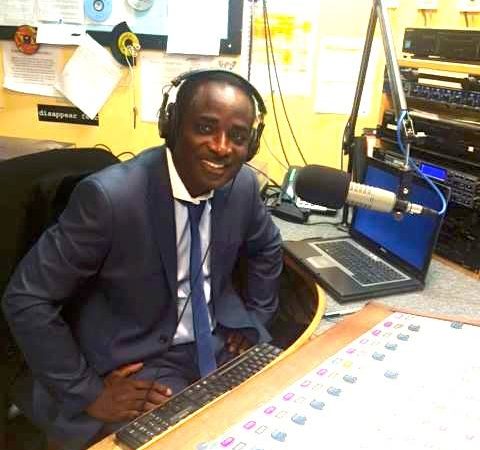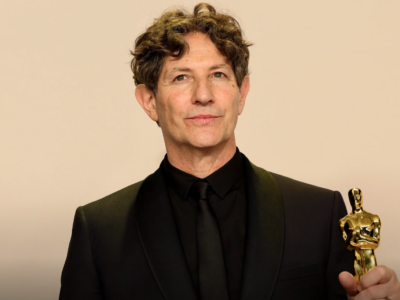
Paul Théa in his studio. Image published with permission.
Through his films featuring victims and their families, Paul Théa has long been involved in telling the stories of the horrors of Guinea's Camp Boiro. He has recently started a project documenting the slave route from where slaves were captured in the coastal regions of Guinea to their final destination in North America.
Global Voices (GV): Recently we've seen you post very enthusiastic messages on Facebook about reclaiming an old building. What is that all about?
Paul Théa (PT): Il s’agit d’un bâtiment colonial du nom de PZ (Patterson /Zochonis), le nom de la compagnie qui l’a construit. Le bâtiment est sur un site de Dominya dans la préfecture de Boffa près du port négrier et du comptoir européen, c’est vous dire que c’est un symbole fort pour notre projet qui est d’en faire un musée de la route de l’esclave. Ma première demande fut refusée il y a plus de 20 ans et c’est à la troisième tentative que j’ai eu les autorisations du Ministère du Tourisme. Il était temps car le bâtiment est très abîmé, je profite de l’occasion pour remercier toutes les bonnes volontés qui ont aidé dans l’obtention du site.
Paul Théa (PT): It's all about a colonial building named PZ (Patterson/ Zochonis), after the company that built it. The building is on a site in Dominya in the Bossa Prefecture, next to the slave port and the European trading post. That makes it a highly symbolic place for our project, which aims to turn it into a museum about the slave route. My first request was refused more than 20 years ago and now, after the third attempt, I have been given authorisation by the Ministry of Tourism. It was time to do so because the building is very run-down. I'd like to take this opportunity to thank all the supporters who have helped me gain access to the site.
PT: En fait il y a plusieurs routes, nous travaillons en ce moment sur le sujet, je peux tout de même vous citer la route de Timbo, la capitale du Fouta théocratique jusqu’à Farinya chez les Nyara Belli (chez les Lightburn), du Fortin de Boké au port négrier de Dominya etc. Il y a le port de Dubréka et le port de Benty à Forécariah, j’attends les cartes des routes pour donner plus de détails.
PT: In actual fact, there are several routes. We are working on finding out more about them at the moment. But I can mention the Timbo Route, from the capital of the historical Fouta Djallon state to the village of Farinya and the Nyara Belli/Lightburn trading point, and from the fort at Boké to the slave port of Dominya. There is the port of Dubréka, and the port of Benty in the Forécariah Prefecture. I am waiting for the maps of the routes before I can give more details.
PT: Non pas du tout, il y a de nombreuses initiatives pour jeter plus de lumière sur ce douloureux passé. Par exemple, il y a eu un colloque international sur “La tradition orale et la traite négrière“, tenu à Conakry en mars 1997 ou encore une réunion des experts sur “Les archives européennes de la traite négrière”, qui a eu lieu à Copenhague en février de l'année suivante. Les comptes-rendus ont été publiés par l’UNESCO. Par contre, à ma connaissance, nous sommes les premiers à proposer un musée sur l’esclavage en Guinée et en plus d’y inclure l’histoire de ces esclaves transportés en Caroline du Sud par exemple. Ce que nous proposons aura aussi l'avantage de présenter aux visiteurs, non seulement des sites, mais aussi des documents vidéos. C’est la raison pour laquelle je fais en ce moment un documentaire sur le sujet en Guinée et je dois par la suite aller en Caroline du Sud pour rencontrer la communauté Gullah/Geechee, les descendants des esclaves venus essentiellement de la côte Ouest africaine, de l’Angola et de Madagascar.
PT: No, not at all. There have been many initiatives to shed more light on this painful past. For example, an international conference on “Oral Tradition and the Slave Trade” was held in Conakry in March 1997. In February the following year, a group of experts met in Copenhagen to discuss “European Archives of the Slave Trade”. Reports on both meetings have been published by UNESCO. However, to my knowledge, we are the first to propose a museum about slavery in Guinea and to include the history of slaves who were transported to South Carolina. What we propose has the advantage of presenting visitors with documentary videos, as well as having them experience the sites themselves. This is why I am making a documentary on this subject in Guinea and why I will go to South Carolina afterwards to meet the Gullah/Geechee community, who are the descendants of the slaves who came from the West African coast, Angola, and Madagascar.
PT: Je formais les premiers guides touristiques en Guinée, en mai et juin 2017, et dans la pratique sur le terrain, nous sommes allés au port négrier de Dubréka, ensuite à Dominya. Ce sont les témoignages des habitants sur l’envoi des esclaves du port négrier de Dominya en Caroline du Sud qui fit le déclic. Internet et quelques interlocuteurs me firent comprendre l’ampleur du commerce triangulaire dans le Rio Pongo, loin devant Gorée au Sénégal. Parmi les négriers blancs installés dans cette région, il y avait des Américains tel que Louis Lightburn, le mari de Nyara Belli, une marchande d’esclaves, très connue à l'époque, issue d’une grande famille locale qui avait des champs de riz en Caroline du Sud ; les esclaves étaient prisés des riziculteurs. Lightburn ravitaillait sa famille en esclaves. Toujours dans le Rio Pongo, des esclaves se libérèrent et fondèrent des villages. Pour un réalisateur, impossible de rater un tel sujet!
PT: I drew up the first tourist guides in Guinea in May and June 2017. We went to the slave port of Dubréka, then Dominya as part of our fieldwork. The lightbulb moment came from the inhabitants’ accounts of how slaves were sent from the Dominya slave port to South Carolina. The internet and several conversations I had made me understand the scale of the triangular trade in the Rio Pongo. It was much larger than that of the Island of Gorée in Senegal. Amongst the white slavers who moved to the region were many Americans, such as Louis Lightburn. He was the husband of Nyara Belli, a well known slave trader of the time, from a large local family who had rice fields in South Carolina. The slaves were prized by the rice growers. Lightburn supplied his family with slaves. Still, in the Rio Pongo, slaves freed themselves and founded villages. It is impossible for a filmmaker to miss out on such a story!
PT: Comme je le disais tantôt, les esclaves transportés en Caroline du Sud et installés le long de la côte Est venaient de différentes ethnies ; ils créèrent une langue (créole) pour se comprendre et ils gardèrent les cultures africaines qu’ils défendent jalousement, encore aujourd'hui. Gullah est une déformation de Gola, une ethnie de la Sierra Léone et Geechee, une déformation de Kissi, une autre ethnie de la Sierra et de la Guinée. Ils disent la Nation Gullah Geechee et ils ont une cheftaine qui parcourt le monde entier pour la promotion de leur culture, de la langue qui se perd et pour la défense de leurs droits car ils perdent aussi les terres de leurs ancêtres.
As I was saying earlier, the slaves transported to South Carolina and all along the East Coast came from many different origins. They created the Creole language to understand one another and kept their African cultures, which they defend jealously to this day. Gullah is a corruption of Gola, a cultural group from Sierra Leone, and Geechee is a corruption of Kissi, another group from Sierra Leone and Guinea. They call themselves the Gullah/Geechee Nation and have a chief who goes all over the world to promote their culture, their language which is dying out, and to defend their rights, because they are also losing their ancestral lands.
PT: Nous venons de boucler la rédaction du projet que nous allons envoyer aux différentes institutions et même aux musées de l’esclavage pour une collaboration ou un financement.
PT: We have just finished writing up the project and we are going to send it to different institutions and even to slavery museums to see if they are willing to collaborate or to support the project financially.
PT: Pour l’instant tout vient de ma poche et comme je ne suis pas riche, je fais appel aux bonnes volontés pour au moins sponsoriser le documentaire. Naturellement les noms des sponsors seront dûment mentionnés dans les crédits lors de la finition de la vidéo ; c’est un travail qui prend du temps et de l’argent, mais comme il sera important pour les générations qui viendront, je m’y adonne.
PT: Everything is being paid for out of my pocket for the moment. As I am not rich, I am appealing to supporters to sponsor the documentary at least. Of course, the sponsors’ names duly appear in the credits at the end of the video. It is work that requires time and money, but as it is important for the generations to come, I dedicate myself to it.
PT: Le Ministère du Tourisme comprend bien l’importance de la route de l’esclave comme produit touristique pour lancer le tourisme en Guinée, pour preuve, les cadres de ce département se sont mobilisés pour me faciliter l’obtention du site. Je présenterai le projet en Guinée en Octobre après mon passage en Caroline du Sud et à ce moment-là je parlerai du degré de collaboration avec les institutions.
PT: The Ministry of Tourism understands the importance of the slave route as a product that can attract tourists to Guinea. The way that leaders of the department acted to help me obtain the site proves that. I will present the project in Guinea in October after my trip to South Carolina, and at that moment I will talk about the level of collaboration with the insitutions.
Paul Théa is a filmmaker, radio and TV presenter, and communications specialist. He studied Economic and Social Administration at the University of Montpelier, France; IT Administration at Toulouse's Institut de Promotion Commerciale; and TV and Radio in the US. Théa's films can also be found on his YouTube channel.






